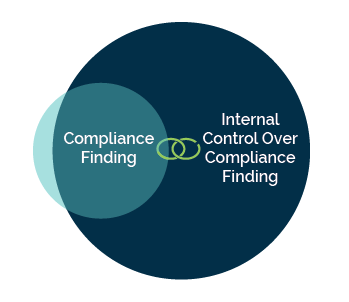
Oh No, an Audit Finding!
- Published
- Feb 23, 2024
- Share
There are many misconceptions about what it means to have a finding reported in the schedule of findings and questioned costs. Some individuals believe that a finding means they could lose their job or receive embarrassing press, while others may ignore the information altogether. So, what is an audit finding? Why is it important? What does it tell us? To answer these questions, one must first understand why the auditor must report findings and what they convey.
What is the purpose of an audit?
Let’s consider two types of audits: a financial statement audit and a compliance audit. A financial statement audit is designed to provide assurance to a user of financial statements, whereas a compliance audit, like a Single Audit for federal grants, provides assurance to providers of funds and other stakeholders that funds were administered compliantly.
If your organization receives state or federal funds, your entity may be required to obtain a financial statement audit in accordance with Government Audit Standards, an audit of compliance pursuant to Subpart F of the Uniform Guidance (aka Single Audit), or both. Under these standards, the following reports and schedules are required:
- The auditor’s report on the financial statements.
- A report on internal controls over financial reporting and compliance and other matters.
- A report on compliance for each major program and on internal controls over compliance, and (if subject to Single Audit).
- A schedule of findings and questioned costs.
In performing these audits with the goal of issuing the above reports, an auditor considers internal controls over financial reporting and those over compliance with certain laws, regulations, contracts, and/or grants to determine whether the financial statements might be misstated or noncompliance might exist.
What is an audit finding?
In that process of reviewing internal controls and compliance, if an auditor identifies weaknesses in internal control issues or instances of noncompliance, the auditing standards require, in certain circumstances, that these matters be reported in writing. There are two types of internal control findings that may be identified by the auditor. These are as follows:
- A significant deficiency is a deficiency, or a combination of deficiencies, in internal controls that is less severe than a material weakness, yet important enough to merit attention by those charged with governance.
- A material weakness is a deficiency, or combination of deficiencies, in internal controls that leads to a reasonable possibility that a material misstatement of the entity’s financial statements will not be prevented, or detected and corrected, on a timely basis.
Noncompliance that may be reported as a finding might involve a range of issues, including those pertaining to federal or state grants, payroll tax matters, restrictions of tax propositions, violations of debt covenants, violations of law, or others that could affect the financial statements or overall compliance with the terms of a grant program. Examples could include failure to file payroll tax returns and submit deposits, disallowed costs charged to a grant, or failure to operate within a budget, which are generally limited to material matters. An intentional act of non-compliance or misappropriation can be considered fraud, which also must be reported as a finding.
It is important to remember that a compliance finding, including those involving fraud, is often an indicator of a potential deficiency in internal controls over compliance. It could, therefore, result in a finding in both areas as the graphic below illustrates:

Evaluating a finding
- Identification data – Agency, program, Assistance Listing (ALN) award number and year.
- Criteria – What is the law, rule or standard?
- Condition – How did the auditee not comply with the law rule or standard?
- Cause – Why did this happen?
- Effect – What is the impact, financial or other, of the finding?
- Questioned costs and how computed – Known costs are reported.
- Recommendations – Auditors’ input on how to remediate the finding.
- View of responsible officials – Auditee provides a response and can reference a corrective action plan, if applicable.
Who’s to blame?
What's on Your Mind?
Start a conversation with the team
Receive the latest business insights, analysis, and perspectives from EisnerAmper professionals.













